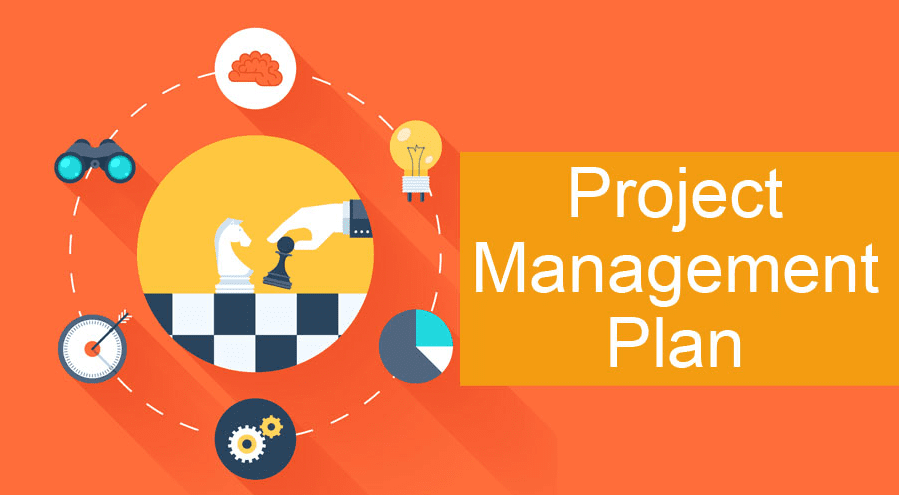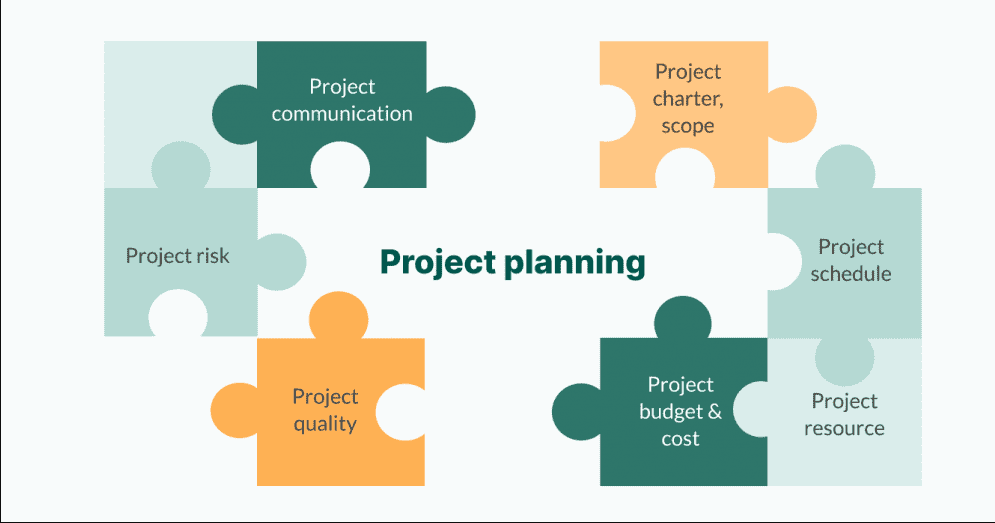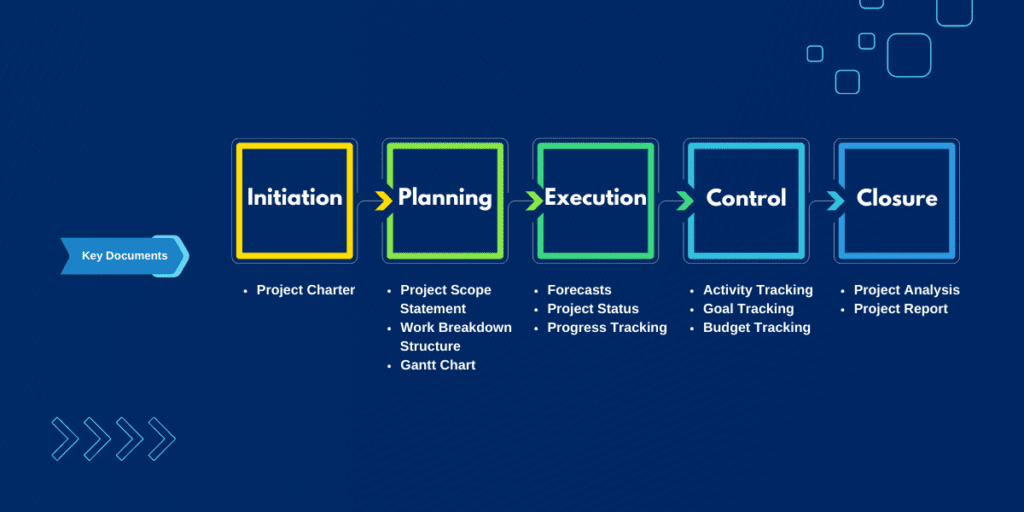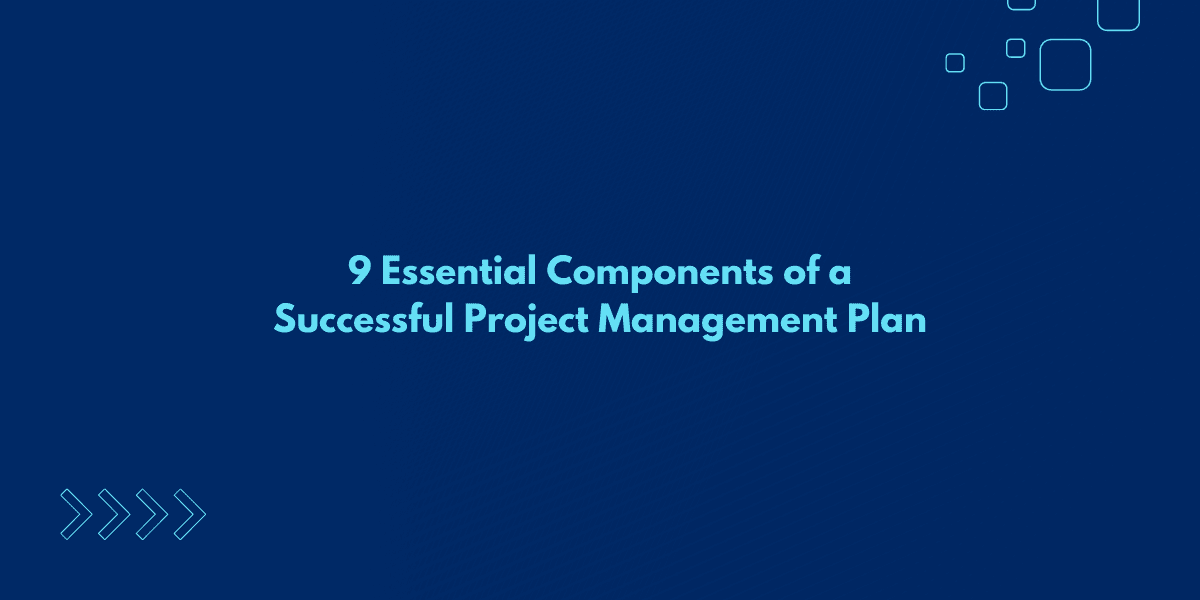If you are looking to manage a project from start to finish effectively, then creating a comprehensive project management plan is essential. A project management plan serves as a roadmap for the entire project, outlining the necessary steps and procedures required to bring your vision to life.
With a project management plan in place, you can better define the scope of your project, identify key stakeholders, establish timelines and budgets, outline risk management strategies, and set clear reporting procedures.
By taking these proactive measures early on in the planning process, you can minimize potential roadblocks or setbacks and ensure that your team stays on track throughout the entirety of the project lifecycle.
What is Project Management Plan?
A project plan for project management serves as a baseline document that outlines the essential components required to accomplish project goals. It encompasses the scope, budget, goals, timeline, and deliverables of the project.
This plan acts as a reference throughout the project’s lifecycle, ensuring that project management activities align with established policies and procedures.
The Significance of a Project Management Plan

A project management project plan plays a pivotal role in the success of any project. It serves as a roadmap, encompassing crucial project elements such as scope, goals, timelines, resources, and risks.
Without a well-structured plan, projects may encounter unexpected obstacles or fail to meet important deadlines. By developing a comprehensive project management plan, you can maintain organization and provide clear guidance to your team.
Effective Communication and Stakeholder Engagement
An elaborate project plan for project management facilitates effective communication with stakeholders and clients. Its transparency and clarity instill confidence in them, as they can easily comprehend the project’s details and progress.
Furthermore, when changes arise during the project, referring back to the original plan enables you to make necessary adjustments while keeping all parties informed.
Cost Control and Resource Optimization
Crafting a detailed project management plan aids in cost control. By breaking down the project into smaller components and estimating costs for each segment, you can identify potential overspending or underspending areas.
This allows for timely adjustments, preventing uncontrolled cost escalation and ensuring optimal resource allocation.
Investing Efforts for Future Success
Although developing a comprehensive project plan for project management may seem like an additional workload, it is a vital step toward ensuring a successful outcome.
By dedicating time upfront to thorough planning, you can anticipate and mitigate challenges, thereby promoting a smooth and efficient project execution in the long run.
Key Components of A Project Management Plan

A project management plan (PMP) is a crucial document that outlines the strategies and methods for effectively managing a project. While specific project details may vary across industries, there are several core components that are essential to include in planning and managing the project.
1. Scope Statement
The scope statement sets the foundation for the project management plan. It involves planning and developing a clear and concise statement that defines the project’s objectives, deliverables, and constraints.
A well-defined scope statement should adhere to the SMART framework (Specific, Measurable, Achievable, Relevant, and Time-Bound) to ensure clarity and focus.
2. Executive Summary
The executive summary provides a concise overview of the project management project plan. It summarizes the key elements and objectives of the project, allowing stakeholders to grasp the essence of the plan without having to review the entire document.
An effective executive summary acts as a quick reference point for stakeholders and helps align their understanding of the project’s purpose.
3. Project Schedule
The project schedule is a critical component that outlines the timeline and sequence of project activities. It includes key milestones, deadlines, and dependencies.
By utilizing strong project management software such as Onethread, project managers can efficiently communicate the project schedule to relevant stakeholders, ensuring everyone knows key dates and deliverables.
4. Project Budget
The project budget section estimates the total cost required to complete the project successfully. It encompasses the combined costs of all activities, tasks, and milestones.
Project managers must carefully estimate and allocate resources, ensuring that the project remains financially feasible and aligned with stakeholder expectations. The project budget should be approved by all relevant stakeholders.
5. Resource Planning
Resource planning involves identifying and allocating the necessary resources, including personnel, equipment, materials, and any other assets required to execute project activities.
Effective resource planning ensures that the right resources are available at the right time, enabling tasks to be completed efficiently. It also helps project managers track resource capacity and make adjustments as needed to optimize project performance.
6. Stakeholder List
The stakeholder list identifies and includes all individuals, groups, or organizations that have an interest or influence on the project. It is important to regularly update and maintain the stakeholder list within the project management plan to ensure comprehensive stakeholder engagement.
By including all stakeholders, regardless of their size or influence, project managers can effectively manage expectations and mitigate risks.
7. Communication Management
Communication is vital for successful project execution. The communication management component within the planning and managing of the project defines the communication strategy and protocols for the project.
It outlines the modes of communication, frequency of updates, and the intended recipients. A well-defined communication strategy ensures that project stakeholders receive timely and relevant information, fostering collaboration and alignment.
8. Risk Register
Risk management is essential to address potential threats that may impact the project’s timeline, performance, or budget. It is a document that identifies, assesses, and prioritizes risks, transforming potential risks into actionable issues.
By regularly updating the risk register, project managers can proactively mitigate risks and take appropriate measures to minimize their impact on project outcomes.
9. Procurement Plan
The procurement plan outlines the process of acquiring external products, services, or resources required for the project. It includes steps such as identifying needs, estimating quantities and costs, specifying quality standards, consolidating similar requirements, and selecting appropriate procurement methods and processes.
The procurement plan also establishes lead times for each procurement activity and provides an implementation table for effective execution.
A comprehensive project management plan incorporates essential components to ensure successful project execution.
How to Create a Project Plan: A Comprehensive Guide

One of the crucial factors for delivering projects successfully is having a well-developed project plan.
You must create a project plan that provides a clear direction for you and your team to work together and toward a thriving future. This guide presents a 10-step approach to help you create an effective project plan.
Step 1: Describe the Project Plan to Key Stakeholders
Before diving into the project details, it is essential to present the project plan and goals to key stakeholders. They have the authority to determine the project’s success and whether they want to invest or not.
During this initial conversation, you should discuss their needs, expectations, and establish a baseline for project scope, timeline, and budget. Utilizing a project plan template can also streamline the process.
Step 2: Define Roles, Responsibilities, and Resources
Poorly defined roles and responsibilities can lead to confusion and hinder project progress. To avoid such issues, it is necessary to determine the roles and responsibilities of each team member from the outset. Clearly defining roles, like project sponsor and project manager, ensure a shared understanding and smooth collaboration.
Step 3: Create a Project Scope
The project scope statement serves as a foundation for the rest of the project plan. It outlines the series of tasks required to achieve each deliverable.
The scope statement should include a justification for the project, a clear description of the scope, an identification of business needs and problems, definition of project deliverables, exclusions, constraints, and assumptions.
A well-defined project scope provides a roadmap for project execution.
Step 4: Craft an Extensive Project Schedule
With project goals and milestones outlined, the next step is to create a comprehensive project schedule. Gantt charts can be valuable for visualizing the project timeline, work scope, and task interdependencies.
By organizing all events, tasks, and milestones in one place, you can effectively manage project timelines and ensure smooth execution.
Step 5: Create Baseline Management Plans
Establishing baselines for scope, schedule, and cost is crucial for managing project variances effectively. Once these baselines are set, create an action plan that outlines how your team will handle deviations from the original plans.
This plan should include a review and approval process for any changes. It’s important to have different approval levels for different types of changes to maintain control over the project’s scope, schedule, and budget.
Step 6: Define the Staffing Plan
The staffing plan is a graphical representation that showcases the time periods during which each resource will be involved in the project. Unlike other project charts, the staffing plan does not include tasks, estimates, start and due dates, or the critical path.
Step 7: Plan for Contingencies
No matter how well you plan, unforeseen circumstances can arise during a project. It is important to anticipate potential problems and plan for contingencies. Consider factors such as team members taking leaves, resignations, changes in sponsorship, or other unexpected events.
By proactively addressing these risks and discussing them with the entire team, you can be prepared and minimize the impact of any challenges that may arise.
Step 8: Analyze Project Quality
Analyzing project quality involves more than simply checking for errors at the end of the project. It requires a solid approach to eliminate errors throughout the project lifecycle.
Developing a quality plan involves establishing standards, acceptance criteria, and metrics that will be used to assess project quality.
This plan becomes the foundation for quality reviews and inspections conducted throughout the project.
Step 9: Communication Plan
Effective communication is the bottom line for project success. A well-defined communication plan establishes guidelines for sharing specific information with relevant stakeholders at the right time.
Consider the information needs of different audience segments and determine the appropriate communication channels to use. Additionally, address the sharing of confidential information and designate individuals responsible for its communication.
Step 10: Monitor and Adapt
Creating a project plan is not a one-time task. It requires continuous monitoring and adaptation throughout the project’s lifecycle. Regularly review the project’s progress against the established plan, track key performance indicators, and identify any deviations or risks.
By staying vigilant and proactive, you can make necessary adjustments, reallocate resources if needed, and ensure that the project stays on track toward successful completion.
Developing a comprehensive project plan is essential for project success. By following these ten steps, you can create a well-structured project plan that provides a clear roadmap for your team, facilitates effective communication, and helps you proactively manage risks and challenges.
Remember, a solid project plan is a dynamic tool that requires regular monitoring and adaptation to ensure successful project delivery.
Project Management Plan Templates: Streamline Your Project Success
A well-executed project management plan is crucial for the success of any project. It consists of various plans and documents that provide a roadmap for project execution and control.
Utilizing planning and managing the project templates can simplify the process by providing a structured framework to capture essential planning details. Let’s check out some templates.
1. Project Researching and Preparing Templates
Project researching and preparing templates are valuable resources for conducting in-depth analysis and gathering necessary information before project initiation. These templates assist in documenting research findings, competitor analysis, market trends, and other relevant data.
They provide a structured approach to research, ensuring that all essential aspects are thoroughly explored and incorporated into the project plan.
2. Cost Estimate and Projected Budget Templates
Accurate cost estimation and budget planning are critical for project success. Cost estimates and projected budget templates enable project managers to estimate costs for labor, resources, materials, and other project expenses.
These templates facilitate the identification of potential cost overruns, help in prioritizing spending, and ensure that the project remains within budgetary constraints.
3. Risk Assessment Templates
Risk assessment templates help project teams identify, evaluate, and mitigate potential risks that could impact project objectives. These templates provide a systematic approach to identifying various risks, assessing their probability and impact, and developing risk response strategies.
By using risk assessment templates, project managers can proactively manage risks and minimize their potential negative effects on project outcomes.
4. Project Implementation and Management Plan Templates
Project implementation and management plan templates outline the strategies, activities, and resources required to effectively execute and monitor project tasks.
These templates cover areas such as project organization, team roles and responsibilities, communication plans, procurement strategies, and quality control measures.
They provide a comprehensive framework for managing project execution, ensuring that all necessary steps are followed to achieve project goals.
5. Project Presentation & Tracking Templates
Project presentation and tracking templates are designed to help you communicate project details effectively and monitor progress throughout the project lifecycle. These templates typically include sections for project objectives, scope, milestones, timelines, team members, and key performance indicators (KPIs).
They serve as a central repository for project information, allowing stakeholders to stay informed and track project status with ease.
These templates provide a structured approach to capturing essential project details. By leveraging these templates, project managers can enhance communication, mitigate risks, control costs, and effectively manage project activities, ultimately driving successful project outcomes.
How Can Onethread Help With Your Project Management Plan?
Effective project planning is crucial for successful project management. To streamline and organize the planning process, project managers and teams can leverage Onethread. An all-in-one project management software. This feature-rich platform offers a centralized location for collaboration and provides a range of powerful tools.
Core Features
1. Flexible Project Views
Kanban View
[GIF OF Board VIEW]
Utilize the drag-and-drop interface to move tasks and monitor their progress through various stages using the Kanban approach.
Table View
[SS OF Table VIEW]
Efficiently assign tasks, filter, and view data based on priority, keeping essential details easily accessible.
Gantt View
[SS OF Gantt VIEW]
Utilize Gantt charts for task visualization, scheduling, tracking progress, and setting dependencies between tasks.
Calendar View
[SS OF Calendar VIEW]
Consolidate your events, tasks, and milestones in one place. Employ recurring tasks and automatic reminders to optimize scheduling.
2. Swift Communication with Onethread Chat
[SS of Creating a discussion room]
Engage in instant messaging with team members or clients, exchanging text, emojis, images, and files for rapid and effective communication.
3. Online Proofing Tools
[GIF of Comment in a feedback]
Enhance your workflow with Onethread’s proofing software which allows you to annotate, review, and approve files seamlessly. Collaborate on designs and documents by adding comments and marking feedback as resolved.
4. Centralized File Management
[GIF of Attach Files]
Onethread’s file management tool ensures files are organized and easily accessible. Attach files to tasks, discussions, chats, and notes as needed.
5. Custom Roles and Permissions
Achieve optimal control by creating custom project roles. Define what each role can see, manage, and execute. Assign custom roles to team members or clients as per their responsibilities.
6. Task Management and Time Tracking
[SS of Timesheet]
Manage tasks effectively by assigning them to individuals or groups and breaking them into subtasks. Use timesheets and time tracking tools to monitor logged hours, set time estimates, and create custom time reports.
7. Note-Taking Capability
Create, store, and collaborate on notes efficiently. Attach files to notes and organize them for easy access.
8. Scheduling and Calendar Tools
Schedule events, tasks, and milestones with Onethread’s calendar. Set automatic reminders and recurring events to keep on top of your schedule.
9. Reporting Tools
[SS of View Report]
Use the online reporting tool to analyze project progress through detailed custom reports. Monitor milestones, task statuses, and workflow progress to adjust plans accordingly.
10. Discussions and Collaboration
Centralize team and client discussions, sharing ideas, files, and documents in one place without relying on lengthy email threads.
Supercharge your project planning with Onethread!
Onethread is a cloud-based project management software that offers a comprehensive set of tools for project planning. It helps users effectively organize their projects, streamline project management processes, enhance team collaboration, and increase productivity.
By leveraging its features, teams can efficiently handle project tasks and achieve their goals more efficiently.
Conclusion
So, you’ve learned what is project management plan and the importance of a project management plan and the key components that make it effective. Now it’s time to put that knowledge into action.
Creating a successful project management plan requires careful planning, clear communication, and diligent monitoring. It may seem like a daunting task at first, but with the right tools and strategies in place, you can ensure your project stays on track and achieves its objectives.
Remember to define clear goals and milestones, allocate resources effectively, keep stakeholders informed throughout the process, and be prepared to adapt as needed along the way. With these steps in mind, you’ll be well on your way to completing your project successfully!
Frequently Asked Questions
What Are Some Common Challenges That Project Managers Face When Creating A Project Management Plan?
When creating a project management plan, you may face challenges such as a lack of resources, unclear objectives, and scope changes. It’s important to stay organized and communicate effectively with team members to overcome these obstacles.
How Can A Project Manager Ensure All Stakeholders Are Effectively Communicated throughout the Project?
To ensure effective communication with stakeholders, you need to identify their needs and expectations from the project. Use various channels like emails, meetings, and progress reports to keep them informed regularly.
What Are Some Techniques for Estimating Project Timelines and Budgets?
To estimate project timelines and budgets, you can use techniques like expert judgment, analogous estimating, parametric estimating, and three-point estimating. These methods help you create realistic timelines and budgets based on past experiences and data analysis.
How Can Risk Management be Incorporated into A Project Management Plan?
To incorporate risk management into your plan, identify potential risks and their impact on the project. Develop a response strategy for each risk and establish protocols for monitoring and addressing them throughout the project lifecycle.
What is The Role Of Change Management in A Project Management Plan, And How Can It be Effectively Implemented?
To effectively implement change management in your project, establish a clear process for requesting and approving changes, communicate changes to stakeholders, assess the impact of changes on the project timeline and budget, and ensure proper documentation of all changes.
